Analysis of Cost, Budgeting and Variance in Financial Resources
VerifiedAdded on 2023/06/15
|13
|2623
|292
Report
AI Summary
This report provides a detailed analysis of managing financial resources, covering key aspects such as cost calculation (prime cost, production cost, sales & distribution cost, administration expenses, and total cost), budgeting and forecasting techniques, variance analysis, and different types of budget...
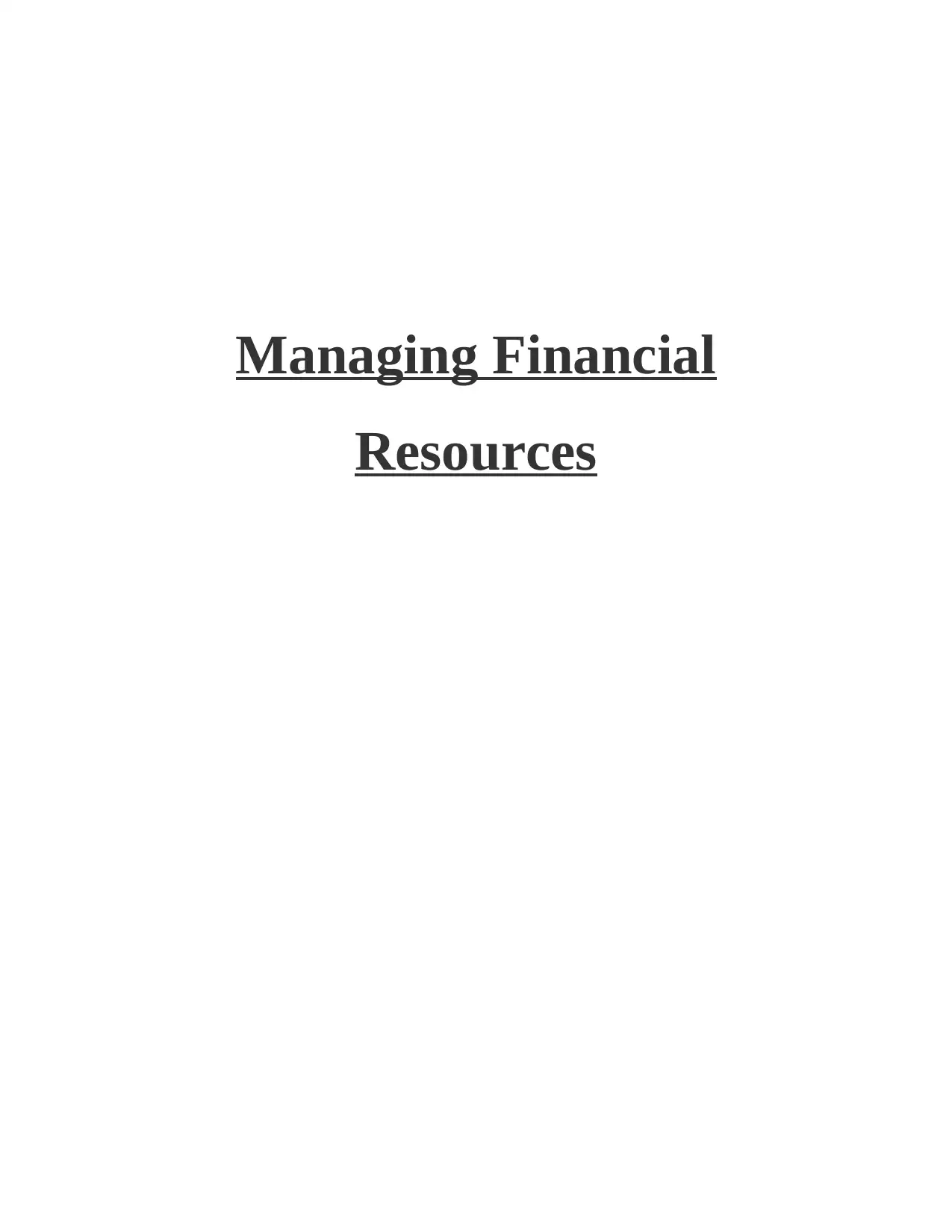
Managing Financial
Resources
Resources
Paraphrase This Document
Need a fresh take? Get an instant paraphrase of this document with our AI Paraphraser

TABLE OF CONTENTS
MAIN BODY..................................................................................................................................1
SECTION A.....................................................................................................................................1
QUESTION 1.............................................................................................................................1
SECTION B....................................................................................................................................4
Question 4....................................................................................................................................4
Question 6....................................................................................................................................8
REFERENCES..............................................................................................................................11
MAIN BODY..................................................................................................................................1
SECTION A.....................................................................................................................................1
QUESTION 1.............................................................................................................................1
SECTION B....................................................................................................................................4
Question 4....................................................................................................................................4
Question 6....................................................................................................................................8
REFERENCES..............................................................................................................................11
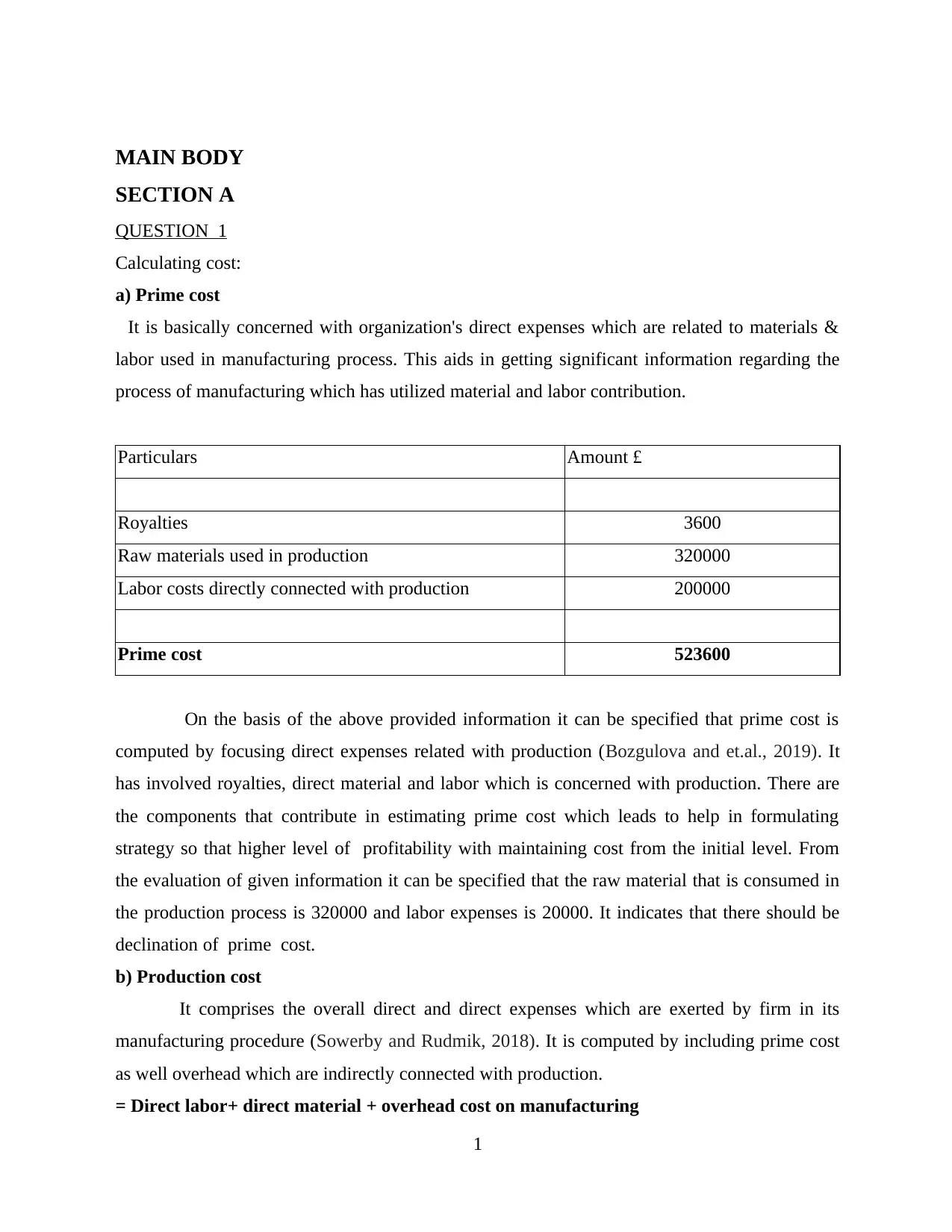
MAIN BODY
SECTION A
QUESTION 1
Calculating cost:
a) Prime cost
It is basically concerned with organization's direct expenses which are related to materials &
labor used in manufacturing process. This aids in getting significant information regarding the
process of manufacturing which has utilized material and labor contribution.
Particulars Amount £
Royalties 3600
Raw materials used in production 320000
Labor costs directly connected with production 200000
Prime cost 523600
On the basis of the above provided information it can be specified that prime cost is
computed by focusing direct expenses related with production (Bozgulova and et.al., 2019). It
has involved royalties, direct material and labor which is concerned with production. There are
the components that contribute in estimating prime cost which leads to help in formulating
strategy so that higher level of profitability with maintaining cost from the initial level. From
the evaluation of given information it can be specified that the raw material that is consumed in
the production process is 320000 and labor expenses is 20000. It indicates that there should be
declination of prime cost.
b) Production cost
It comprises the overall direct and direct expenses which are exerted by firm in its
manufacturing procedure (Sowerby and Rudmik, 2018). It is computed by including prime cost
as well overhead which are indirectly connected with production.
= Direct labor+ direct material + overhead cost on manufacturing
1
SECTION A
QUESTION 1
Calculating cost:
a) Prime cost
It is basically concerned with organization's direct expenses which are related to materials &
labor used in manufacturing process. This aids in getting significant information regarding the
process of manufacturing which has utilized material and labor contribution.
Particulars Amount £
Royalties 3600
Raw materials used in production 320000
Labor costs directly connected with production 200000
Prime cost 523600
On the basis of the above provided information it can be specified that prime cost is
computed by focusing direct expenses related with production (Bozgulova and et.al., 2019). It
has involved royalties, direct material and labor which is concerned with production. There are
the components that contribute in estimating prime cost which leads to help in formulating
strategy so that higher level of profitability with maintaining cost from the initial level. From
the evaluation of given information it can be specified that the raw material that is consumed in
the production process is 320000 and labor expenses is 20000. It indicates that there should be
declination of prime cost.
b) Production cost
It comprises the overall direct and direct expenses which are exerted by firm in its
manufacturing procedure (Sowerby and Rudmik, 2018). It is computed by including prime cost
as well overhead which are indirectly connected with production.
= Direct labor+ direct material + overhead cost on manufacturing
1
⊘ This is a preview!⊘
Do you want full access?
Subscribe today to unlock all pages.

Trusted by 1+ million students worldwide
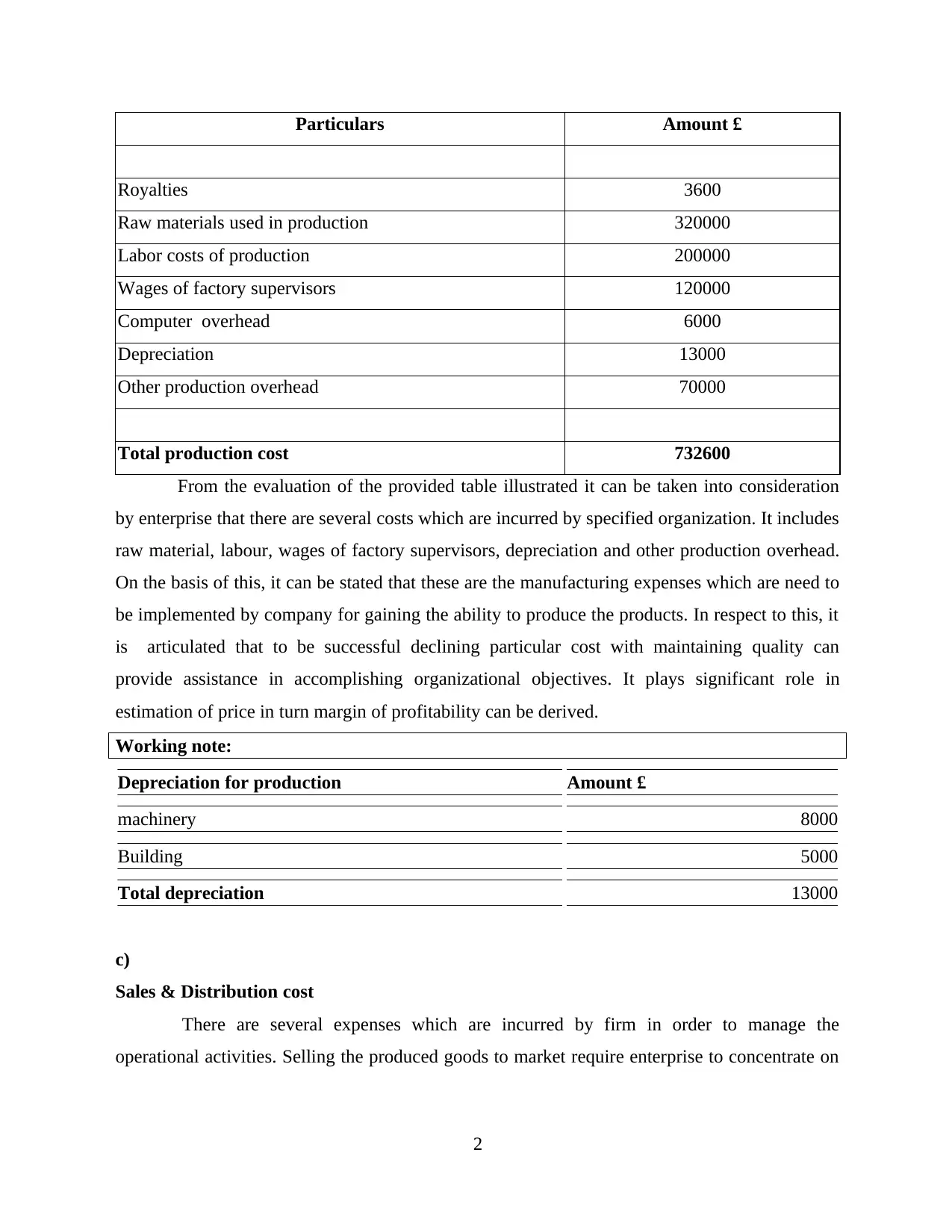
Particulars Amount £
Royalties 3600
Raw materials used in production 320000
Labor costs of production 200000
Wages of factory supervisors 120000
Computer overhead 6000
Depreciation 13000
Other production overhead 70000
Total production cost 732600
From the evaluation of the provided table illustrated it can be taken into consideration
by enterprise that there are several costs which are incurred by specified organization. It includes
raw material, labour, wages of factory supervisors, depreciation and other production overhead.
On the basis of this, it can be stated that these are the manufacturing expenses which are need to
be implemented by company for gaining the ability to produce the products. In respect to this, it
is articulated that to be successful declining particular cost with maintaining quality can
provide assistance in accomplishing organizational objectives. It plays significant role in
estimation of price in turn margin of profitability can be derived.
Working note:
Depreciation for production Amount £
machinery 8000
Building 5000
Total depreciation 13000
c)
Sales & Distribution cost
There are several expenses which are incurred by firm in order to manage the
operational activities. Selling the produced goods to market require enterprise to concentrate on
2
Royalties 3600
Raw materials used in production 320000
Labor costs of production 200000
Wages of factory supervisors 120000
Computer overhead 6000
Depreciation 13000
Other production overhead 70000
Total production cost 732600
From the evaluation of the provided table illustrated it can be taken into consideration
by enterprise that there are several costs which are incurred by specified organization. It includes
raw material, labour, wages of factory supervisors, depreciation and other production overhead.
On the basis of this, it can be stated that these are the manufacturing expenses which are need to
be implemented by company for gaining the ability to produce the products. In respect to this, it
is articulated that to be successful declining particular cost with maintaining quality can
provide assistance in accomplishing organizational objectives. It plays significant role in
estimation of price in turn margin of profitability can be derived.
Working note:
Depreciation for production Amount £
machinery 8000
Building 5000
Total depreciation 13000
c)
Sales & Distribution cost
There are several expenses which are incurred by firm in order to manage the
operational activities. Selling the produced goods to market require enterprise to concentrate on
2
Paraphrase This Document
Need a fresh take? Get an instant paraphrase of this document with our AI Paraphraser
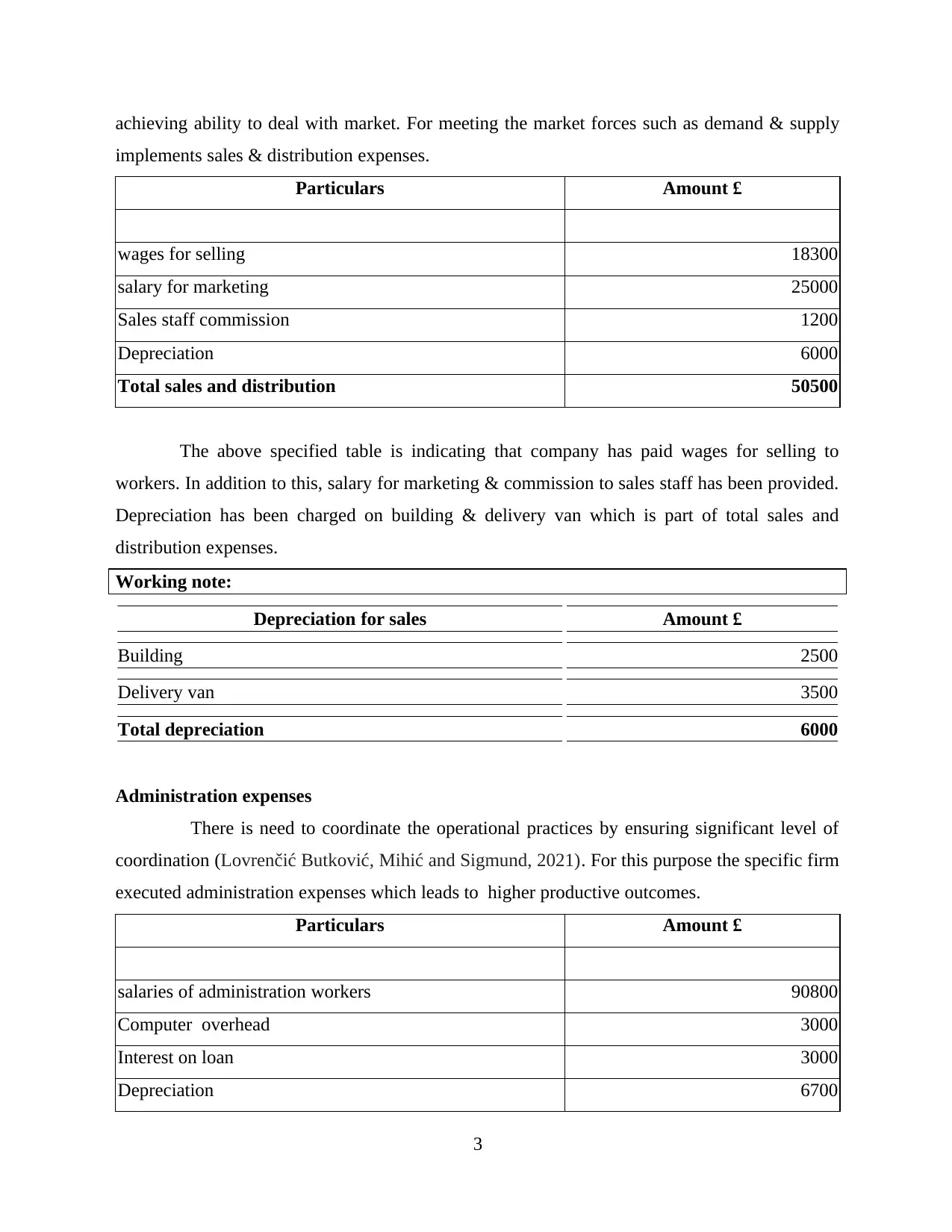
achieving ability to deal with market. For meeting the market forces such as demand & supply
implements sales & distribution expenses.
Particulars Amount £
wages for selling 18300
salary for marketing 25000
Sales staff commission 1200
Depreciation 6000
Total sales and distribution 50500
The above specified table is indicating that company has paid wages for selling to
workers. In addition to this, salary for marketing & commission to sales staff has been provided.
Depreciation has been charged on building & delivery van which is part of total sales and
distribution expenses.
Working note:
Depreciation for sales Amount £
Building 2500
Delivery van 3500
Total depreciation 6000
Administration expenses
There is need to coordinate the operational practices by ensuring significant level of
coordination (Lovrenčić Butković, Mihić and Sigmund, 2021). For this purpose the specific firm
executed administration expenses which leads to higher productive outcomes.
Particulars Amount £
salaries of administration workers 90800
Computer overhead 3000
Interest on loan 3000
Depreciation 6700
3
implements sales & distribution expenses.
Particulars Amount £
wages for selling 18300
salary for marketing 25000
Sales staff commission 1200
Depreciation 6000
Total sales and distribution 50500
The above specified table is indicating that company has paid wages for selling to
workers. In addition to this, salary for marketing & commission to sales staff has been provided.
Depreciation has been charged on building & delivery van which is part of total sales and
distribution expenses.
Working note:
Depreciation for sales Amount £
Building 2500
Delivery van 3500
Total depreciation 6000
Administration expenses
There is need to coordinate the operational practices by ensuring significant level of
coordination (Lovrenčić Butković, Mihić and Sigmund, 2021). For this purpose the specific firm
executed administration expenses which leads to higher productive outcomes.
Particulars Amount £
salaries of administration workers 90800
Computer overhead 3000
Interest on loan 3000
Depreciation 6700
3

Total administration cost 103500
From the above illustrated calculation it can be articulated that for administration
practices it has given salaries to workers, overhead of computer, interest on loan, and
depreciation has been conducted. On the basis of this, it can be stated that managing the
administration activities is highly crucial for gaining the success. It leads to managing &
updating an organizational employee, ensuring optimum utilization of resources, etc. From the
computation it can be specified that 103500 has been incurred. It contributes in developing
strategic approach in turn managing operational practices having higher profitability can become
possible.
Depreciation for administration Amount £
Office fixtures and fittings 4200
Building 2500
Total depreciation 6700
d) Total cost
This is basically associated with the overall expenses incurred by firm for meeting the
objective of delivering goods to consumer. It comprises all the direct and indirect cost which are
conducted for smooth functioning of organization.
Particulars Amount £
Prime cost 523600
Production cost 732600
Sales and distribution 50500
Administration cost 103500
Total cost 1410200
` It can be recognized that in the given case the larger share is covered by production.
Prime, administration and sales & distribution expenses are incurred respectively. In the total
cost sales & distribution expenses has been spent less than compared to other activities. On the
basis of this, it can be identified that these are the overall expenditure doe by organization.
4
From the above illustrated calculation it can be articulated that for administration
practices it has given salaries to workers, overhead of computer, interest on loan, and
depreciation has been conducted. On the basis of this, it can be stated that managing the
administration activities is highly crucial for gaining the success. It leads to managing &
updating an organizational employee, ensuring optimum utilization of resources, etc. From the
computation it can be specified that 103500 has been incurred. It contributes in developing
strategic approach in turn managing operational practices having higher profitability can become
possible.
Depreciation for administration Amount £
Office fixtures and fittings 4200
Building 2500
Total depreciation 6700
d) Total cost
This is basically associated with the overall expenses incurred by firm for meeting the
objective of delivering goods to consumer. It comprises all the direct and indirect cost which are
conducted for smooth functioning of organization.
Particulars Amount £
Prime cost 523600
Production cost 732600
Sales and distribution 50500
Administration cost 103500
Total cost 1410200
` It can be recognized that in the given case the larger share is covered by production.
Prime, administration and sales & distribution expenses are incurred respectively. In the total
cost sales & distribution expenses has been spent less than compared to other activities. On the
basis of this, it can be identified that these are the overall expenditure doe by organization.
4
⊘ This is a preview!⊘
Do you want full access?
Subscribe today to unlock all pages.

Trusted by 1+ million students worldwide

SECTION B
Question 4
1. Budgeting and forecasting
It is the process of forecasting revenue and expenditure of the organization for the
specified period. There are several advantages which can be obtained by business by
implementing budgeting method in order to manage the overall practices. It is basically a road
map which is obtained via preparing budget so that forecasting of unforeseen circumstances can
be done. In this respect it can be identified that conducting preliminary analysis, identifying
revenue expectation, contingency fund & implementing suitable course can become possible.
There are different kinds of budget which can be formulated by firm that includes h
performance, fixed, flexed, incremental, zero based, cash, etc.
Particulars Quarter 1 Quarter 2 Quarter 3 Quarter 4
Fore casted unit
sales 5000 6000 7000 8000
Product price per
unit 20 20 21 22
Total gross sales 100000 120000 147000 176000
-Sales discount &
allowances 1000 2000 3000 4000
Net sale 99000 118000 144000 172000
The above presented budget of sales is helpful in forecasting that there will be
inclination of number of units sales along with rising prices. On the basis of this, it can be
interpreted that sales will be increased in quarter 4 as compared to the one. The trend in sales
fore casted as per the budget formulated is upward going.
2. Variance analysis
Variance analysis is concerned with studying the deviation of actual and budgeted. It
helps in estimating the difference that occurred between the actual and planned activity or
performance. This permits formulating significant strategy by identifying the lacking areas &
5
Question 4
1. Budgeting and forecasting
It is the process of forecasting revenue and expenditure of the organization for the
specified period. There are several advantages which can be obtained by business by
implementing budgeting method in order to manage the overall practices. It is basically a road
map which is obtained via preparing budget so that forecasting of unforeseen circumstances can
be done. In this respect it can be identified that conducting preliminary analysis, identifying
revenue expectation, contingency fund & implementing suitable course can become possible.
There are different kinds of budget which can be formulated by firm that includes h
performance, fixed, flexed, incremental, zero based, cash, etc.
Particulars Quarter 1 Quarter 2 Quarter 3 Quarter 4
Fore casted unit
sales 5000 6000 7000 8000
Product price per
unit 20 20 21 22
Total gross sales 100000 120000 147000 176000
-Sales discount &
allowances 1000 2000 3000 4000
Net sale 99000 118000 144000 172000
The above presented budget of sales is helpful in forecasting that there will be
inclination of number of units sales along with rising prices. On the basis of this, it can be
interpreted that sales will be increased in quarter 4 as compared to the one. The trend in sales
fore casted as per the budget formulated is upward going.
2. Variance analysis
Variance analysis is concerned with studying the deviation of actual and budgeted. It
helps in estimating the difference that occurred between the actual and planned activity or
performance. This permits formulating significant strategy by identifying the lacking areas &
5
Paraphrase This Document
Need a fresh take? Get an instant paraphrase of this document with our AI Paraphraser
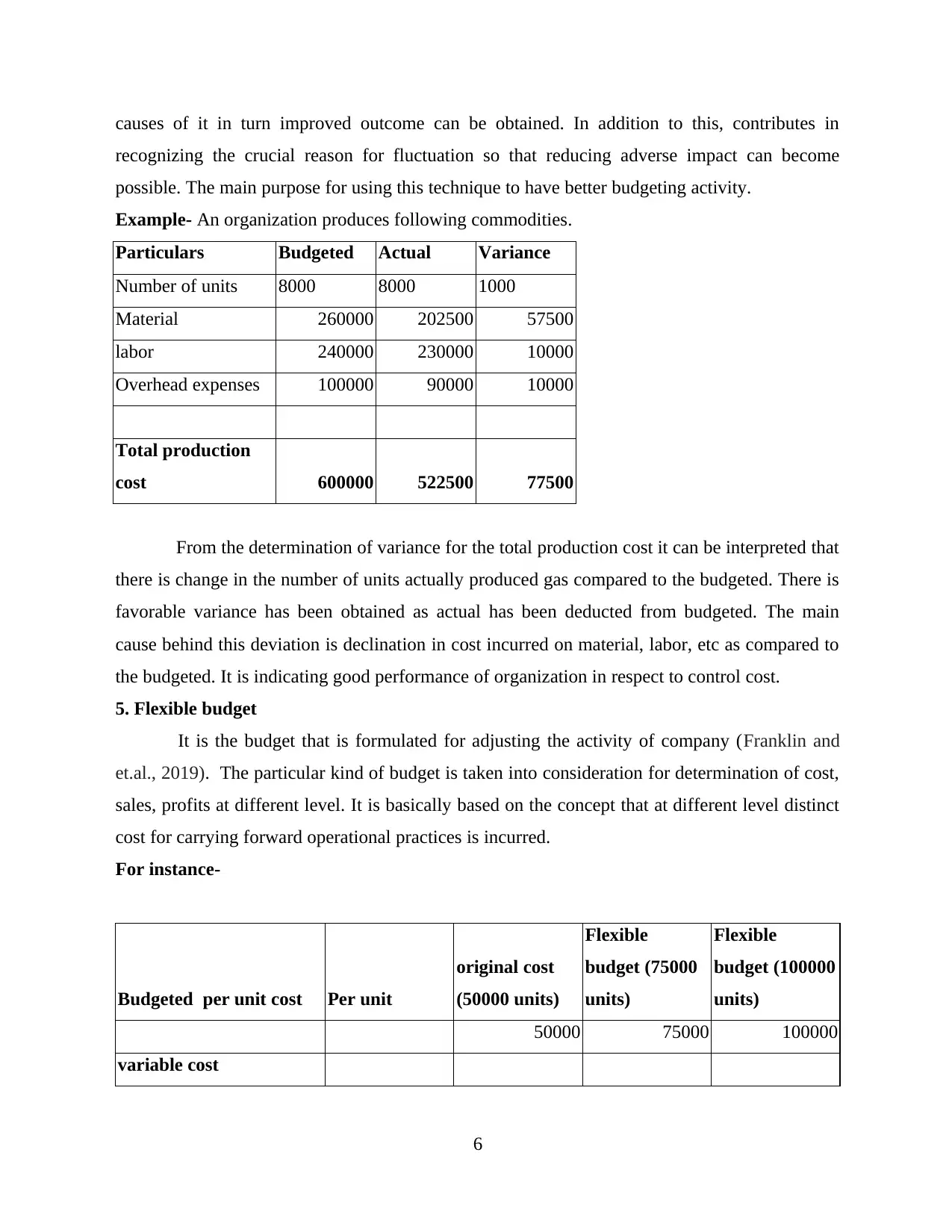
causes of it in turn improved outcome can be obtained. In addition to this, contributes in
recognizing the crucial reason for fluctuation so that reducing adverse impact can become
possible. The main purpose for using this technique to have better budgeting activity.
Example- An organization produces following commodities.
Particulars Budgeted Actual Variance
Number of units 8000 8000 1000
Material 260000 202500 57500
labor 240000 230000 10000
Overhead expenses 100000 90000 10000
Total production
cost 600000 522500 77500
From the determination of variance for the total production cost it can be interpreted that
there is change in the number of units actually produced gas compared to the budgeted. There is
favorable variance has been obtained as actual has been deducted from budgeted. The main
cause behind this deviation is declination in cost incurred on material, labor, etc as compared to
the budgeted. It is indicating good performance of organization in respect to control cost.
5. Flexible budget
It is the budget that is formulated for adjusting the activity of company (Franklin and
et.al., 2019). The particular kind of budget is taken into consideration for determination of cost,
sales, profits at different level. It is basically based on the concept that at different level distinct
cost for carrying forward operational practices is incurred.
For instance-
Budgeted per unit cost Per unit
original cost
(50000 units)
Flexible
budget (75000
units)
Flexible
budget (100000
units)
50000 75000 100000
variable cost
6
recognizing the crucial reason for fluctuation so that reducing adverse impact can become
possible. The main purpose for using this technique to have better budgeting activity.
Example- An organization produces following commodities.
Particulars Budgeted Actual Variance
Number of units 8000 8000 1000
Material 260000 202500 57500
labor 240000 230000 10000
Overhead expenses 100000 90000 10000
Total production
cost 600000 522500 77500
From the determination of variance for the total production cost it can be interpreted that
there is change in the number of units actually produced gas compared to the budgeted. There is
favorable variance has been obtained as actual has been deducted from budgeted. The main
cause behind this deviation is declination in cost incurred on material, labor, etc as compared to
the budgeted. It is indicating good performance of organization in respect to control cost.
5. Flexible budget
It is the budget that is formulated for adjusting the activity of company (Franklin and
et.al., 2019). The particular kind of budget is taken into consideration for determination of cost,
sales, profits at different level. It is basically based on the concept that at different level distinct
cost for carrying forward operational practices is incurred.
For instance-
Budgeted per unit cost Per unit
original cost
(50000 units)
Flexible
budget (75000
units)
Flexible
budget (100000
units)
50000 75000 100000
variable cost
6
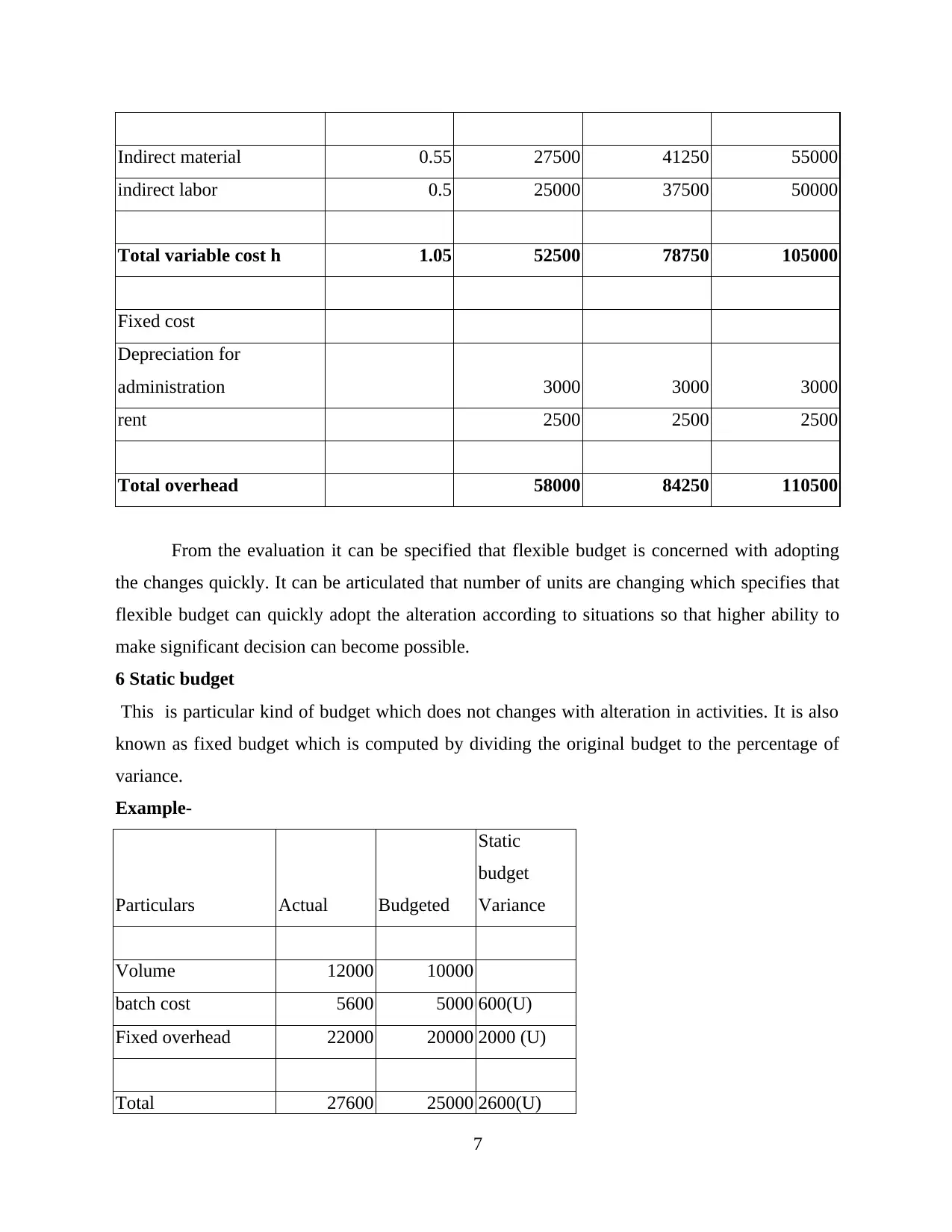
Indirect material 0.55 27500 41250 55000
indirect labor 0.5 25000 37500 50000
Total variable cost h 1.05 52500 78750 105000
Fixed cost
Depreciation for
administration 3000 3000 3000
rent 2500 2500 2500
Total overhead 58000 84250 110500
From the evaluation it can be specified that flexible budget is concerned with adopting
the changes quickly. It can be articulated that number of units are changing which specifies that
flexible budget can quickly adopt the alteration according to situations so that higher ability to
make significant decision can become possible.
6 Static budget
This is particular kind of budget which does not changes with alteration in activities. It is also
known as fixed budget which is computed by dividing the original budget to the percentage of
variance.
Example-
Particulars Actual Budgeted
Static
budget
Variance
Volume 12000 10000
batch cost 5600 5000 600(U)
Fixed overhead 22000 20000 2000 (U)
Total 27600 25000 2600(U)
7
indirect labor 0.5 25000 37500 50000
Total variable cost h 1.05 52500 78750 105000
Fixed cost
Depreciation for
administration 3000 3000 3000
rent 2500 2500 2500
Total overhead 58000 84250 110500
From the evaluation it can be specified that flexible budget is concerned with adopting
the changes quickly. It can be articulated that number of units are changing which specifies that
flexible budget can quickly adopt the alteration according to situations so that higher ability to
make significant decision can become possible.
6 Static budget
This is particular kind of budget which does not changes with alteration in activities. It is also
known as fixed budget which is computed by dividing the original budget to the percentage of
variance.
Example-
Particulars Actual Budgeted
Static
budget
Variance
Volume 12000 10000
batch cost 5600 5000 600(U)
Fixed overhead 22000 20000 2000 (U)
Total 27600 25000 2600(U)
7
⊘ This is a preview!⊘
Do you want full access?
Subscribe today to unlock all pages.

Trusted by 1+ million students worldwide
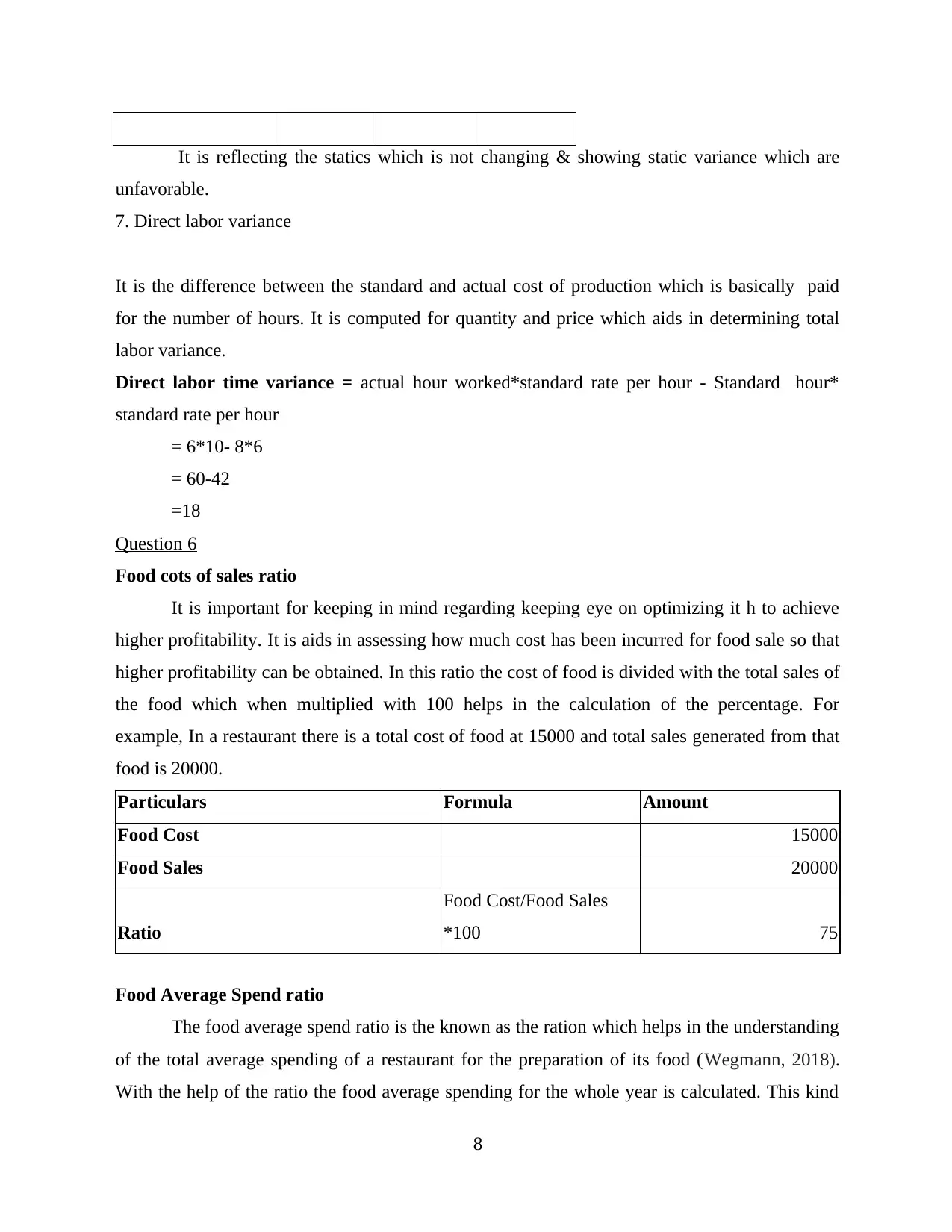
It is reflecting the statics which is not changing & showing static variance which are
unfavorable.
7. Direct labor variance
It is the difference between the standard and actual cost of production which is basically paid
for the number of hours. It is computed for quantity and price which aids in determining total
labor variance.
Direct labor time variance = actual hour worked*standard rate per hour - Standard hour*
standard rate per hour
= 6*10- 8*6
= 60-42
=18
Question 6
Food cots of sales ratio
It is important for keeping in mind regarding keeping eye on optimizing it h to achieve
higher profitability. It is aids in assessing how much cost has been incurred for food sale so that
higher profitability can be obtained. In this ratio the cost of food is divided with the total sales of
the food which when multiplied with 100 helps in the calculation of the percentage. For
example, In a restaurant there is a total cost of food at 15000 and total sales generated from that
food is 20000.
Particulars Formula Amount
Food Cost 15000
Food Sales 20000
Ratio
Food Cost/Food Sales
*100 75
Food Average Spend ratio
The food average spend ratio is the known as the ration which helps in the understanding
of the total average spending of a restaurant for the preparation of its food (Wegmann, 2018).
With the help of the ratio the food average spending for the whole year is calculated. This kind
8
unfavorable.
7. Direct labor variance
It is the difference between the standard and actual cost of production which is basically paid
for the number of hours. It is computed for quantity and price which aids in determining total
labor variance.
Direct labor time variance = actual hour worked*standard rate per hour - Standard hour*
standard rate per hour
= 6*10- 8*6
= 60-42
=18
Question 6
Food cots of sales ratio
It is important for keeping in mind regarding keeping eye on optimizing it h to achieve
higher profitability. It is aids in assessing how much cost has been incurred for food sale so that
higher profitability can be obtained. In this ratio the cost of food is divided with the total sales of
the food which when multiplied with 100 helps in the calculation of the percentage. For
example, In a restaurant there is a total cost of food at 15000 and total sales generated from that
food is 20000.
Particulars Formula Amount
Food Cost 15000
Food Sales 20000
Ratio
Food Cost/Food Sales
*100 75
Food Average Spend ratio
The food average spend ratio is the known as the ration which helps in the understanding
of the total average spending of a restaurant for the preparation of its food (Wegmann, 2018).
With the help of the ratio the food average spending for the whole year is calculated. This kind
8
Paraphrase This Document
Need a fresh take? Get an instant paraphrase of this document with our AI Paraphraser
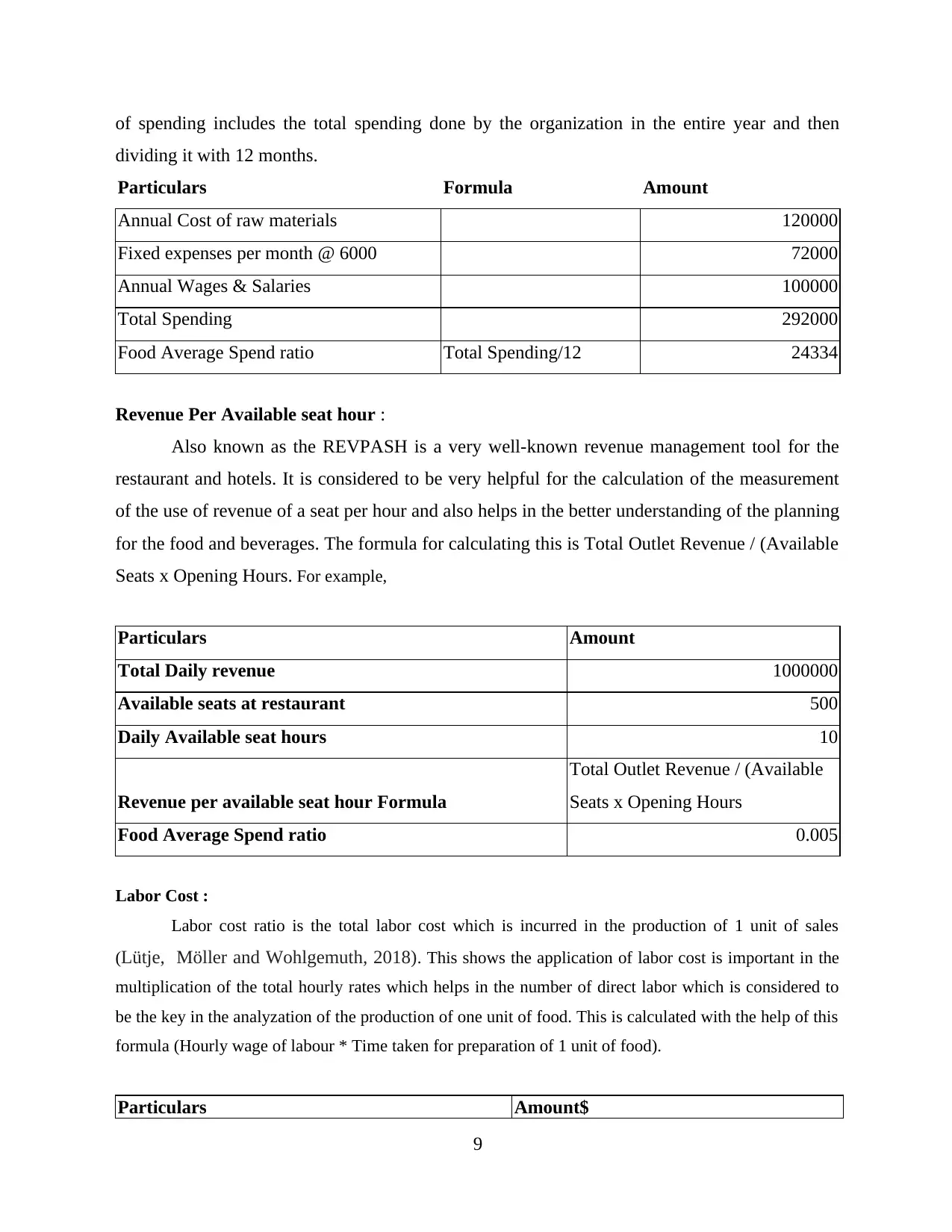
of spending includes the total spending done by the organization in the entire year and then
dividing it with 12 months.
Particulars Formula Amount
Annual Cost of raw materials 120000
Fixed expenses per month @ 6000 72000
Annual Wages & Salaries 100000
Total Spending 292000
Food Average Spend ratio Total Spending/12 24334
Revenue Per Available seat hour :
Also known as the REVPASH is a very well-known revenue management tool for the
restaurant and hotels. It is considered to be very helpful for the calculation of the measurement
of the use of revenue of a seat per hour and also helps in the better understanding of the planning
for the food and beverages. The formula for calculating this is Total Outlet Revenue / (Available
Seats x Opening Hours. For example,
Particulars Amount
Total Daily revenue 1000000
Available seats at restaurant 500
Daily Available seat hours 10
Revenue per available seat hour Formula
Total Outlet Revenue / (Available
Seats x Opening Hours
Food Average Spend ratio 0.005
Labor Cost :
Labor cost ratio is the total labor cost which is incurred in the production of 1 unit of sales
(Lütje, Möller and Wohlgemuth, 2018). This shows the application of labor cost is important in the
multiplication of the total hourly rates which helps in the number of direct labor which is considered to
be the key in the analyzation of the production of one unit of food. This is calculated with the help of this
formula (Hourly wage of labour * Time taken for preparation of 1 unit of food).
Particulars Amount$
9
dividing it with 12 months.
Particulars Formula Amount
Annual Cost of raw materials 120000
Fixed expenses per month @ 6000 72000
Annual Wages & Salaries 100000
Total Spending 292000
Food Average Spend ratio Total Spending/12 24334
Revenue Per Available seat hour :
Also known as the REVPASH is a very well-known revenue management tool for the
restaurant and hotels. It is considered to be very helpful for the calculation of the measurement
of the use of revenue of a seat per hour and also helps in the better understanding of the planning
for the food and beverages. The formula for calculating this is Total Outlet Revenue / (Available
Seats x Opening Hours. For example,
Particulars Amount
Total Daily revenue 1000000
Available seats at restaurant 500
Daily Available seat hours 10
Revenue per available seat hour Formula
Total Outlet Revenue / (Available
Seats x Opening Hours
Food Average Spend ratio 0.005
Labor Cost :
Labor cost ratio is the total labor cost which is incurred in the production of 1 unit of sales
(Lütje, Möller and Wohlgemuth, 2018). This shows the application of labor cost is important in the
multiplication of the total hourly rates which helps in the number of direct labor which is considered to
be the key in the analyzation of the production of one unit of food. This is calculated with the help of this
formula (Hourly wage of labour * Time taken for preparation of 1 unit of food).
Particulars Amount$
9
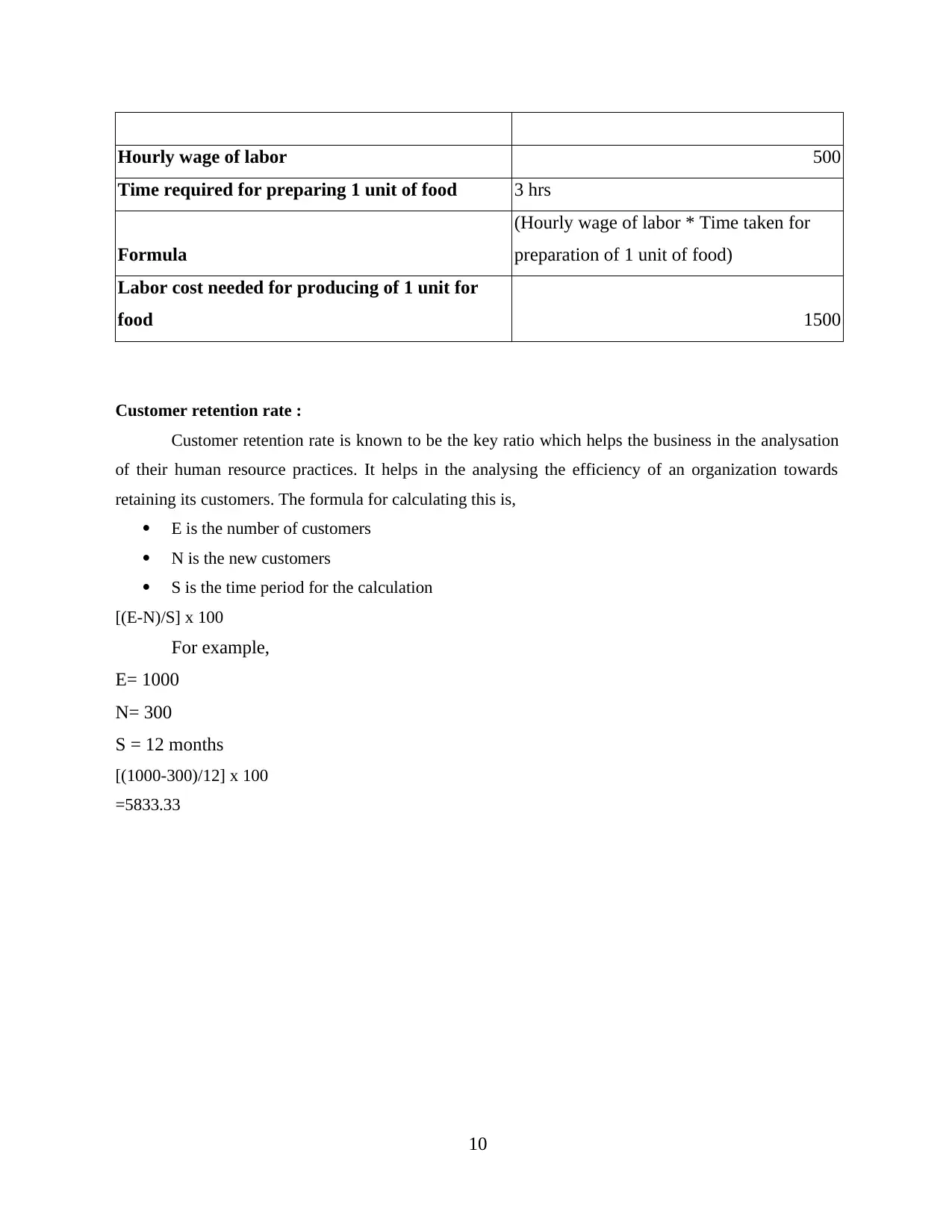
Hourly wage of labor 500
Time required for preparing 1 unit of food 3 hrs
Formula
(Hourly wage of labor * Time taken for
preparation of 1 unit of food)
Labor cost needed for producing of 1 unit for
food 1500
Customer retention rate :
Customer retention rate is known to be the key ratio which helps the business in the analysation
of their human resource practices. It helps in the analysing the efficiency of an organization towards
retaining its customers. The formula for calculating this is,
E is the number of customers
N is the new customers
S is the time period for the calculation
[(E-N)/S] x 100
For example,
E= 1000
N= 300
S = 12 months
[(1000-300)/12] x 100
=5833.33
10
Time required for preparing 1 unit of food 3 hrs
Formula
(Hourly wage of labor * Time taken for
preparation of 1 unit of food)
Labor cost needed for producing of 1 unit for
food 1500
Customer retention rate :
Customer retention rate is known to be the key ratio which helps the business in the analysation
of their human resource practices. It helps in the analysing the efficiency of an organization towards
retaining its customers. The formula for calculating this is,
E is the number of customers
N is the new customers
S is the time period for the calculation
[(E-N)/S] x 100
For example,
E= 1000
N= 300
S = 12 months
[(1000-300)/12] x 100
=5833.33
10
⊘ This is a preview!⊘
Do you want full access?
Subscribe today to unlock all pages.

Trusted by 1+ million students worldwide
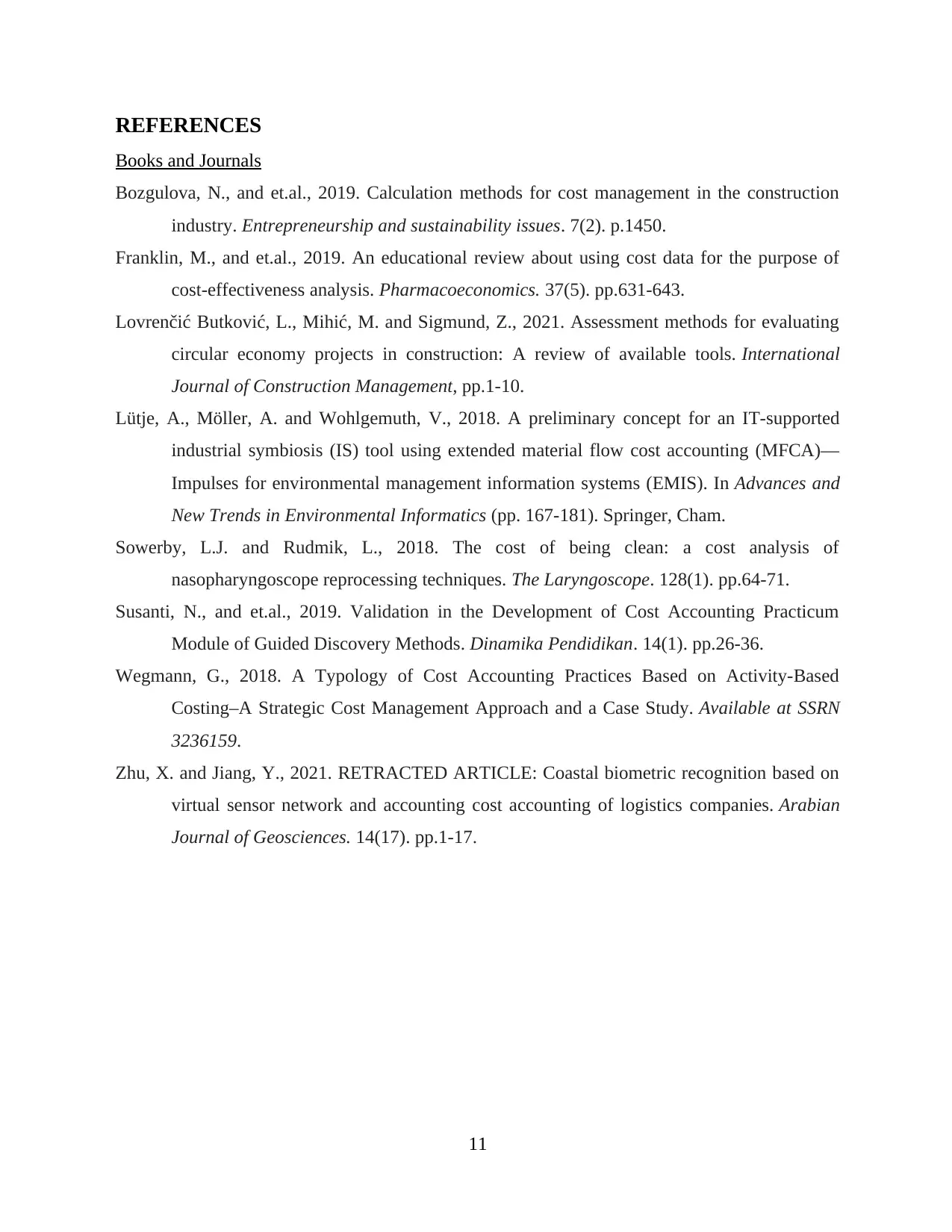
REFERENCES
Books and Journals
Bozgulova, N., and et.al., 2019. Calculation methods for cost management in the construction
industry. Entrepreneurship and sustainability issues. 7(2). p.1450.
Franklin, M., and et.al., 2019. An educational review about using cost data for the purpose of
cost-effectiveness analysis. Pharmacoeconomics. 37(5). pp.631-643.
Lovrenčić Butković, L., Mihić, M. and Sigmund, Z., 2021. Assessment methods for evaluating
circular economy projects in construction: A review of available tools. International
Journal of Construction Management, pp.1-10.
Lütje, A., Möller, A. and Wohlgemuth, V., 2018. A preliminary concept for an IT-supported
industrial symbiosis (IS) tool using extended material flow cost accounting (MFCA)—
Impulses for environmental management information systems (EMIS). In Advances and
New Trends in Environmental Informatics (pp. 167-181). Springer, Cham.
Sowerby, L.J. and Rudmik, L., 2018. The cost of being clean: a cost analysis of
nasopharyngoscope reprocessing techniques. The Laryngoscope. 128(1). pp.64-71.
Susanti, N., and et.al., 2019. Validation in the Development of Cost Accounting Practicum
Module of Guided Discovery Methods. Dinamika Pendidikan. 14(1). pp.26-36.
Wegmann, G., 2018. A Typology of Cost Accounting Practices Based on Activity-Based
Costing–A Strategic Cost Management Approach and a Case Study. Available at SSRN
3236159.
Zhu, X. and Jiang, Y., 2021. RETRACTED ARTICLE: Coastal biometric recognition based on
virtual sensor network and accounting cost accounting of logistics companies. Arabian
Journal of Geosciences. 14(17). pp.1-17.
11
Books and Journals
Bozgulova, N., and et.al., 2019. Calculation methods for cost management in the construction
industry. Entrepreneurship and sustainability issues. 7(2). p.1450.
Franklin, M., and et.al., 2019. An educational review about using cost data for the purpose of
cost-effectiveness analysis. Pharmacoeconomics. 37(5). pp.631-643.
Lovrenčić Butković, L., Mihić, M. and Sigmund, Z., 2021. Assessment methods for evaluating
circular economy projects in construction: A review of available tools. International
Journal of Construction Management, pp.1-10.
Lütje, A., Möller, A. and Wohlgemuth, V., 2018. A preliminary concept for an IT-supported
industrial symbiosis (IS) tool using extended material flow cost accounting (MFCA)—
Impulses for environmental management information systems (EMIS). In Advances and
New Trends in Environmental Informatics (pp. 167-181). Springer, Cham.
Sowerby, L.J. and Rudmik, L., 2018. The cost of being clean: a cost analysis of
nasopharyngoscope reprocessing techniques. The Laryngoscope. 128(1). pp.64-71.
Susanti, N., and et.al., 2019. Validation in the Development of Cost Accounting Practicum
Module of Guided Discovery Methods. Dinamika Pendidikan. 14(1). pp.26-36.
Wegmann, G., 2018. A Typology of Cost Accounting Practices Based on Activity-Based
Costing–A Strategic Cost Management Approach and a Case Study. Available at SSRN
3236159.
Zhu, X. and Jiang, Y., 2021. RETRACTED ARTICLE: Coastal biometric recognition based on
virtual sensor network and accounting cost accounting of logistics companies. Arabian
Journal of Geosciences. 14(17). pp.1-17.
11
1 out of 13
Related Documents
Your All-in-One AI-Powered Toolkit for Academic Success.
+13062052269
info@desklib.com
Available 24*7 on WhatsApp / Email
![[object Object]](/_next/static/media/star-bottom.7253800d.svg)
Unlock your academic potential
© 2024 | Zucol Services PVT LTD | All rights reserved.

